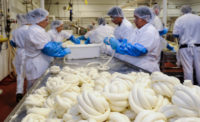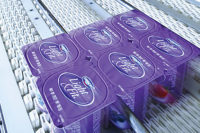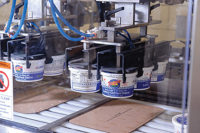All of the milk and cream used to make Tillamook products is tested to ensure it meets its strict quality standards. Tillamook has a quality control lab that tests for components and performs microbiological tests from the time milk arrives to the creation of a finished product. The milk doesn’t sit in the silo for very long. A co-op member said the milk he ships is cheese 12 hours later.
An on-site sensory lab grades all in-process products and performs some quality tests. Tillamook also offers a mastitis lab as a benefit to the farmer-owners to help them identify efficiencies and ensure
cow health.
Dale Baumgartner has been making cheese for Tillamook for 44 years. Today he is the head cheesemaker, overseeing eight cooking vats (called double-O’s), each holding 53,500 pounds of milk. Inside, two agitators distribute annatto coloring and cultures throughout the milk. Tillamook worked with dairy scientists at Oregon State University to develop its own unique starter.
“Every tank of starter is its own little animal,” Baumgartner said. As the micro-organisms in the starter interact with the milk, the watchful eye of an experienced cheesemaker is required to fine-tune any adjustments that need to be made. This part of the process cannot be automated.
After the starter is added, Baumgartner introduces the rennet and curds begin to form. From the cooking vats, the mixture is pumped to the cheddarmaster, which has a capacity of about 15,000 pounds. Here, the cheese is formed into blankets, about 7 inches deep and 5 feet wide. The cheese is salted to drain the whey and to regulate the acid development, Baumgartner said.
Then the cheese moves to block-forming towers. Each tower (there are eight of them) can hold 23 blocks. A guillotine cuts the cheese into 40-pound blocks, which are vacuum-sealed in 4-mil bags. These are conveyed to cold storage where they sit for 18 hours before moving to the warehouse. Two sample blocks from every vat are sent to the lab to be analyzed for salt, fat, moisture and other components. After 70 days, the cheese is graded.








